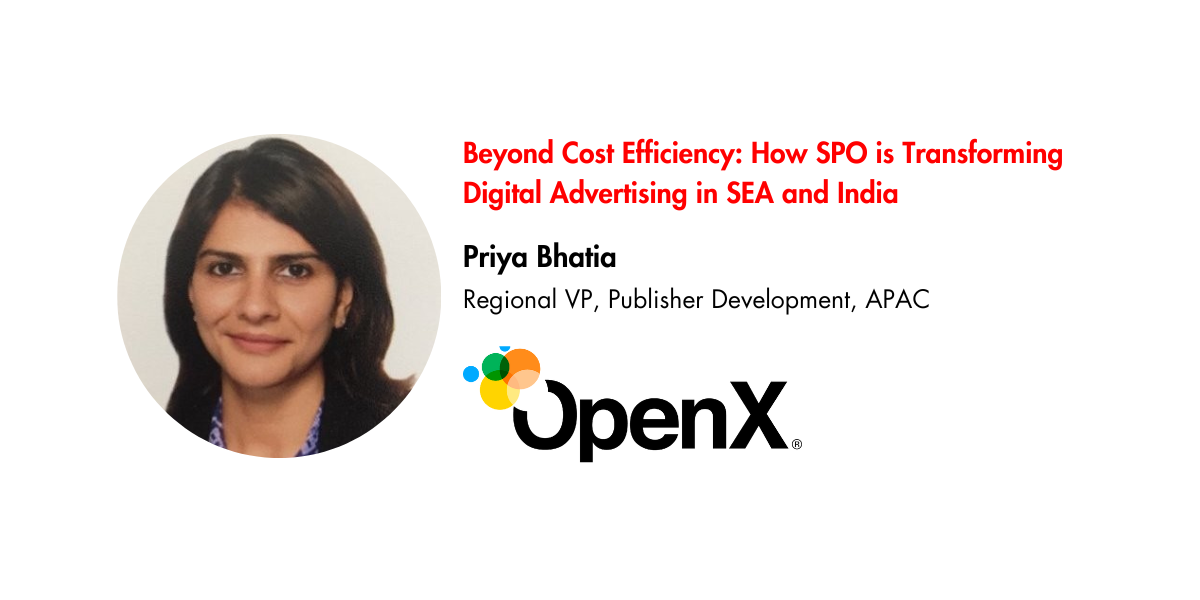In this thought leadership article, Priya Bhatia, Regional VP Publisher Development at OpenX, explores how Supply Path Optimisation (SPO) is reshaping digital advertising across Southeast Asia and India. Drawing on extensive industry experience, Priya examines the unique challenges facing these rapidly growing markets and provides strategic insights on implementing effective SPO practices to enhance transparency, reduce fraud, and maximise advertising performance beyond mere cost efficiency.
The Growing Imperative for SPO in Southeast Asia and India
In the dynamic markets of Southeast Asia (SEA) and India, where digital advertising is growing rapidly, issues like fraud and low-quality inventory are becoming an increasing concern per DoubleVerify’s first APAC-focused Global Insights Report. Although adoption of SPO has been slower in these regions compared to more mature markets, the need for streamlined, transparent ad paths has never been more crucial. SPO not only helps advertisers get more value from their programmatic investments but also ensures that ads are placed in environments that enhance brand safety and audience engagement.

For advertisers and publishers, adopting an SPO strategy can reduce the number of intermediaries in the buying process, leading to greater efficiency and transparency. This approach allows for more control over where ad dollars are spent, improving both performance and accountability across campaigns.
The Current State of Inventory Quality in SEA and India
SEA and India represents unique advertising environments characterised by immense scale, diverse languages, and relatively lower CPMs compared to global averages according to Dentsu Indonesia. India, in particular, is distinguished by its rapid adoption of OTT and CTV platforms, which are driven by high-quality creative content, evolving media strategies, and an English-speaking talent pool. Despite these strengths, the market remains heavily relationship-driven, often necessitating constant in-person engagement and quick decision-making cycles.
Beyond these constraints, the region faces persistent challenges around inventory quality, including ad fraud, viewability issues, and brand safety concerns. Advertisers frequently prioritise cost efficiency, which can sometimes come at the expense of quality. While there is growing awareness among buyers and publishers around the importance of metrics beyond just performance, adoption remains slow. And the use of invalid traffic (IVT) scanning tools is still limited, exacerbating the issue of ad fraud.
As the industry moves beyond vanity metrics, it becomes increasingly clear that setting standards and implementing robust measurement tools are critical to achieving sustainable growth and meaningful audience connections.
Understanding SPO
SPO addresses these challenges by streamlining the ad buying process and enhancing efficiency. In traditional programmatic transactions, ads often pass through multiple intermediaries that each take a share of the revenue. This ”seller-hopping” creates financial waste and reduces transparency, making it difficult for advertisers to understand where their money is going.
SPO helps by eliminating unnecessary middlemen, thereby reducing fees and allowing more of the ad spend to be directed towards actual media buys. For SEA and India, this means greater control over ad placements, improved ad performance, and access to high-quality inventory. With fewer intermediaries involved, campaigns see enhanced metrics like higher viewability, lower latency, and better overall ad delivery.

Key Considerations for SEA and India
Implementing SPO in SEA and India is not without its complexities. The region’s fragmented media landscape, diverse adtech ecosystem, and varying regulatory standards pose significant hurdles. Misalignment between global practices and local market realities can make it difficult for advertisers to enforce consistent inventory quality and brand safety measures. Furthermore, local publishers may resist adopting fraud prevention and brand safety tools if not mandated by revenue sources.
To optimise supply paths, advertisers and publishers should start by rigorously evaluating their partners’ inventory quality, transparency policies, and addressability solutions. Regular measurement and optimisation of campaigns are crucial, as is conducting annual reviews of adtech partners to ensure alignment with evolving market needs.
The Need for Differentiated SSPs
Leveraging advanced technology and data analytics is also key to effective SPO. By partnering with adtech providers who offer cutting-edge, privacy-compliant solutions, advertisers can precisely target audiences, optimise spend, and drive better outcomes. This approach not only enhances efficiency but also fosters trust and accountability within the supply chain.
As a direct and trusted partner to the world’s largest publishers and one of only two SSPs TAG Certified for Transparency, OpenX has been instrumental in driving inventory quality and SPO initiatives in India, experiencing significant year-on-year growth in programmatic adoption and ad spend.
The implementation of strategies like header bidding has enabled publishers to maximise revenue from premium inventory, while advertisers benefit from improved transparency and performance. This success demonstrates the potential for SPO to transform the advertising landscape in SEA and India, ensuring that ad dollars are spent more effectively and efficiently.
The Future of Inventory Quality and SPO
Emerging trends in SEA and India, such as the rise of CTV/OTT and mobile-first video, are reshaping the advertising landscape here. However, the region’s diverse language demographics and fragmented market dynamics pose unique challenges that differ from those seen in Western markets. To stay ahead of the curve, advertisers and publishers must prioritise data-driven strategies, leverage advanced identity solutions, and focus on direct supply paths that minimise waste and maximise impact.
Prioritising inventory quality and SPO is essential for advertisers and publishers in SEA and India. By optimising supply paths, advertisers can reduce fees, gain better transparency into what they’re buying, and improve ROAS, while publishers benefit from increased revenue and more predictable outcomes.
As the programmatic landscape continues to evolve, taking proactive steps towards supply path optimisation will be crucial for maximising the value of digital advertising investments. Now is the time to embrace SPO as a strategic priority for driving growth and efficiency in this rapidly changing market.

